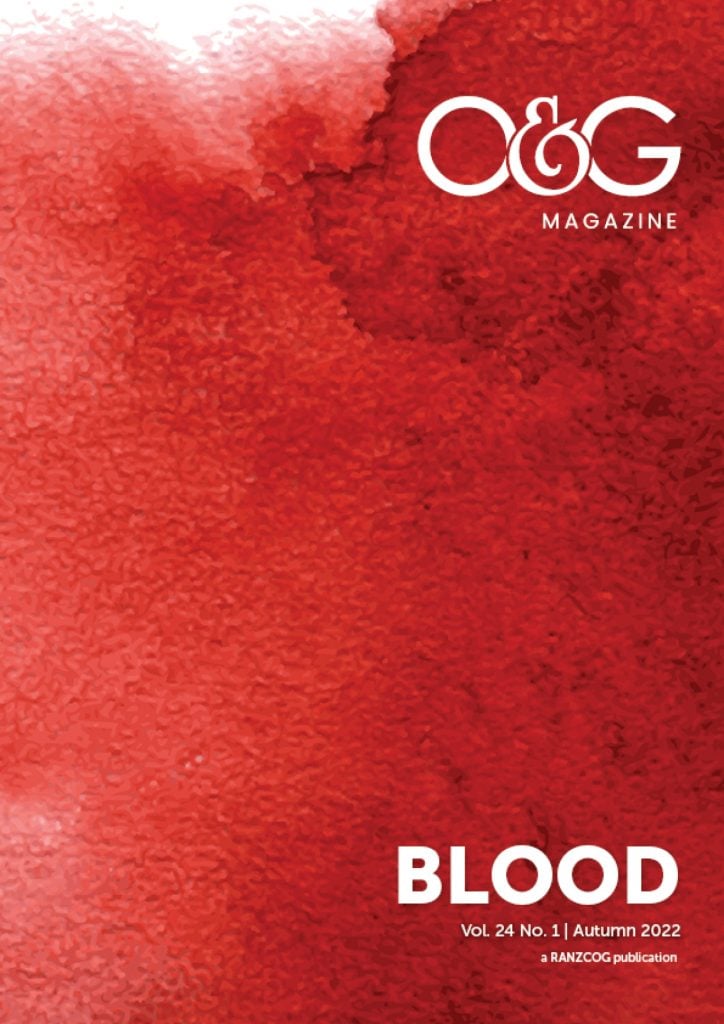When I thought about writing an editorial for this issue of O&G Magazine, I was reminded of all the scary times over my career when bleeding was catastrophic and life threatening. I am also aware of the progress we have made in managing these clinical situations resulting in better outcomes for women.
Blood is vital to life, and for centuries we have known that if we lose too much of it, we die. Blood has its strict medical definition, but in literature and in day-to-day use it has a much wider meaning to include such things as lineage and passion. Examples we hear commonly: makes my blood boil, her blood ran cold, you can’t get blood out of a stone, they have blood on their hands, we need new blood, he is my blood brother and blood is thicker than water.
Early in my career, I had exposure to several incidents of massive haemorrhage. Most O&Gs spend their careers preventing blood loss, whether it be from menstruation, early pregnancy complications, during and after childbirth or related to surgery. We rely on the ability to transfuse blood and other blood products such as platelets and cryoprecipitate to get us out of trouble and save the day.
Whatever branch of medicine we consider, it is interesting to review the history and development, leading up to what we take for granted today. In 1628, an English physician discovered how blood circulated through the body. The earliest blood transfusions occurred in 1665 and the first human blood transfusion was performed in 1795. The first successful blood transfusion was recorded in 1818 by James Blundell, a British obstetrician who transfused a mother with postpartum haemorrhage using her husband’s blood.
In later transfusions, two main problems were identified: collected blood clotted and half the patients had severe reactions.
In 1900, Karl Landsteiner discovered three human blood groups and was awarded the Nobel Prize for medicine for this in 1930. AB was discovered by two of his students in 1902. Soon after, Reuban Ottenberg used blood typing and cross match for the first time.
Transfusions in surgery began in 1903. In 1916, Rous and Turner introduced a citrate-glucose solution that, when added to collected blood, allowed it to be stored and refrigerated for several days before being transfused. In 1926, the British Red Cross instituted the first human blood transfusion service in the world. The first blood bank was established in Leningrad in 1932. The rhesus system was identified in 1939 and named in 1940. By 1950, plastic bags replaced bottles and there have been many advances since. Whole blood fractionation techniques provided the means for efficient use of the various components. Blood is now routinely tested for hepatitis and HIV.
As a trainee intern working in the UK, I met a young woman in hypovolaemic shock from intra-abdominal bleeding secondary to a ruptured ectopic pregnancy. She was Jehovah’s Witness and her family refused blood transfusion for religious reasons and reminded us of this, as we ran down the corridor on our way to theatre. I was shocked and did not understand how a family could allow a young woman to die rather than giving her a blood transfusion. We now have much better understanding of Jehovah Witness belief, patient autonomy, the use of advance directives, ways to minimise blood loss, cell saver use, multidisciplinary management protocols and ways to improve oxygenation.
Blood seen outside the body is a clear red flag, visible to everyone including the patient and her family and almost certainly leads to action. Hidden blood loss is harder to recognise but just as important. I looked after a woman who lost more than twice her blood volume into her retroperitoneal space after a vaginal birth at home. There was no visible bleeding. My previous clinical experience enabled me to recognise what was happening, make the diagnosis and resuscitate her successfully. Her predominant early symptom was severe pain which occurred well before the tachycardia and hypotension. Healthy women with normal haemoglobin and iron stores can lose a vast amount of blood before they decompensate. I learnt this as a student seeing two litres of measured postpartum haemorrhage immediately after delivery without the woman showing any obvious signs or symptoms of blood loss.
The life-threatening bleeds I have been aware of in more recent years have occurred at caesarean section with unrecognised placenta accreta spectrum. This is highly preventable with antenatal diagnosis, referral to an appropriate team and a planned multidisciplinary approach to delivery.
Prevention, recognition and management of postpartum haemorrhage is an important part of our specialty. Improved outcomes for women have occurred with the development of training and guidelines and protocols to manage this complication. We have early warning scores for maternity and also for postoperative care. We have massive transfusion protocols and emergency skills training. It is necessary for us to develop the skills but also involve the multidisciplinary team within our own units.
This issue of O&G Magazine has some surprising articles such as menstruation in COVID and some gaps such as Rhesus disease and anti D prophylaxis. New Zealand’s Anti-D guidelines were updated in 2020 and guidelines for both our College jurisdictions can be found on the RANZCOG website. My early obstetrics was at National Women’s hospital in Auckland New Zealand where I met and learned under Prof William Lilely famous for his early research into the management of rhesus disease in pregnancy. He developed the Liley curve to obtain an indirect measure of amniotic fluid bilirubin. I should have written this article.
There are articles on improving menstrual health, thalassaemia and haemoglobinopathy screening, iron deficiency anaemia, thrombocytopaenia, thromboembolism and umbilical cord banking. I thank the authors for their time and contribution to this issue.





Leave a Reply